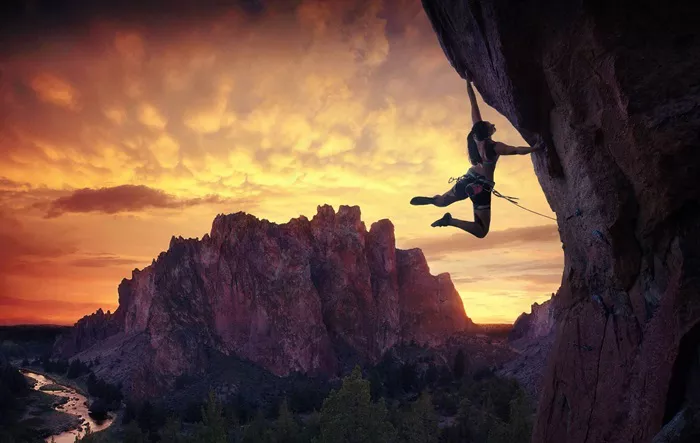Unveiling the Essence of Rock Climbing
Rock climbing, often hailed as the ultimate test of human endurance and skill, stands as a pinnacle of physical and mental prowess. It transcends mere sport; it is a symphony of determination, technique, and communion with nature’s grandeur. As enthusiasts scale vertical cliffs and rugged mountainsides, they embark on a journey that merges the precision of strategy with the exhilaration of spontaneity.
In the realm of rock climbing, every move carries significance beyond its physical execution. It is a dance with gravity, where each handhold and foothold becomes a strategic decision, a calculated risk. The climber’s senses are heightened—the touch of rock, the smell of pine, the sound of wind rushing past—all amplify the experience, creating a sensory tapestry unique to the vertical world.
Beyond the physical demands, rock climbing demands a mental fortitude that navigates fear and doubt. It cultivates resilience, teaching climbers to confront challenges head-on, adapt to unforeseen obstacles, and persist in the face of adversity. The mental game is as crucial as the physical, requiring focus, problem-solving skills, and a deep understanding of one’s limits and strengths.
Moreover, rock climbing is a testament to human potential and exploration. It invites individuals to push beyond comfort zones, to explore remote landscapes inaccessible by conventional means, and to forge connections with both nature and fellow climbers. The community of climbers is diverse and interconnected, sharing a passion that transcends borders and cultures, united by a common love for adventure and the vertical world.
In essence, rock climbing is more than a sport—it is a transformative experience that challenges individuals to discover their inner strength, embrace uncertainty, and celebrate the beauty of natural landscapes. It is a journey of self-discovery and personal growth, where each ascent represents not just a physical achievement, but a triumph of the human spirit against the backdrop of nature’s majestic canvas.
Origins and Evolution
The roots of rock climbing trace back centuries, from early human civilizations seeking vantage points for defense to the Alpine traditions of Europe. What began as a necessity morphed into a pursuit of personal challenge and adventure. Modern rock climbing, as we know it today, evolved through innovation in equipment, techniques, and the exploration of previously unconquerable terrain.
Essential Gear and Equipment
Central to the art of rock climbing is the gear that ensures safety and facilitates movement. From ropes and harnesses to specialized shoes and protective gear, each piece plays a crucial role in the climber’s toolkit. Innovations in material science and design have transformed safety standards and performance capabilities, allowing climbers to push boundaries with confidence.
Techniques and Skill Development
Mastering the Vertical Realm:At its core, rock climbing demands a blend of physical strength, agility, and mental acuity. Climbers engage in rigorous training regimens focused on strength training, flexibility, and endurance. Technique becomes paramount—learning to read rock formations, execute precise movements, and strategize routes efficiently can mean the difference between success and setback.
Types of Rock Climbing
From Bouldering to Big Wall Climbing:Rock climbing encompasses a spectrum of disciplines, each presenting unique challenges and rewards:
Bouldering: Low to the ground, focused on powerful, short climbs without ropes.
Sport Climbing: Ascending fixed routes with pre-placed protection.
Trad (Traditional) Climbing: Placing removable protection as one ascends.
Big Wall Climbing: Multi-day ascents of large rock faces, requiring self-sufficiency and endurance.
Environmental Impact and Conservation
Preserving Our Vertical Playground:With the rise in popularity of rock climbing comes the responsibility to preserve and protect the natural environments we explore. Organizations and climbers alike champion Leave No Trace principles, advocating for minimal impact practices and stewardship of climbing areas. Sustainable access ensures future generations can experience the beauty and challenge of rock climbing.
The Thrill of Achievement
Beyond physical conquests, rock climbing fosters personal growth and a sense of community. Climbers form tight-knit bonds, united by shared experiences and a passion for exploration. The journey—marked by triumphs, setbacks, and self-discovery—transforms individuals into resilient, adaptive adventurers.
Challenges and Risks
Rock climbing, despite its allure, poses inherent risks. Mitigating these risks through proper training, equipment knowledge, and adherence to safety protocols is paramount. Vigilance in assessing weather conditions, route difficulty, and personal limitations ensures a safe and fulfilling climbing experience.
The Future of Rock Climbing
As technology and techniques continue to advance, the future of rock climbing promises new frontiers. From advances in equipment durability and performance to the exploration of uncharted landscapes, the evolution of the sport hinges on innovation, conservation, and a steadfast commitment to pushing boundaries responsibly.
Conclusion
Rock climbing stands not just as a sport but as a testament to human ingenuity and perseverance. It challenges us to reach new heights, both literally and figuratively, and invites us to explore the vertical world with courage and respect. From the crags of Yosemite to the peaks of the Himalayas, climbers embark on journeys that redefine limits and inspire awe. As we gaze upward, we see not just cliffs and mountains, but the promise of adventure and the resilience of the human spirit—a testament to the enduring allure of rock climbing.
In conclusion, rock climbing is a timeless pursuit that embodies the spirit of exploration and the triumph of human potential. It celebrates the thrill of ascent, the camaraderie of shared challenges, and the profound connection between humanity and nature. As climbers continue to push the boundaries of what is possible, they inspire us all to embrace courage, perseverance, and the quest for adventure in our own lives.
Related topics:

